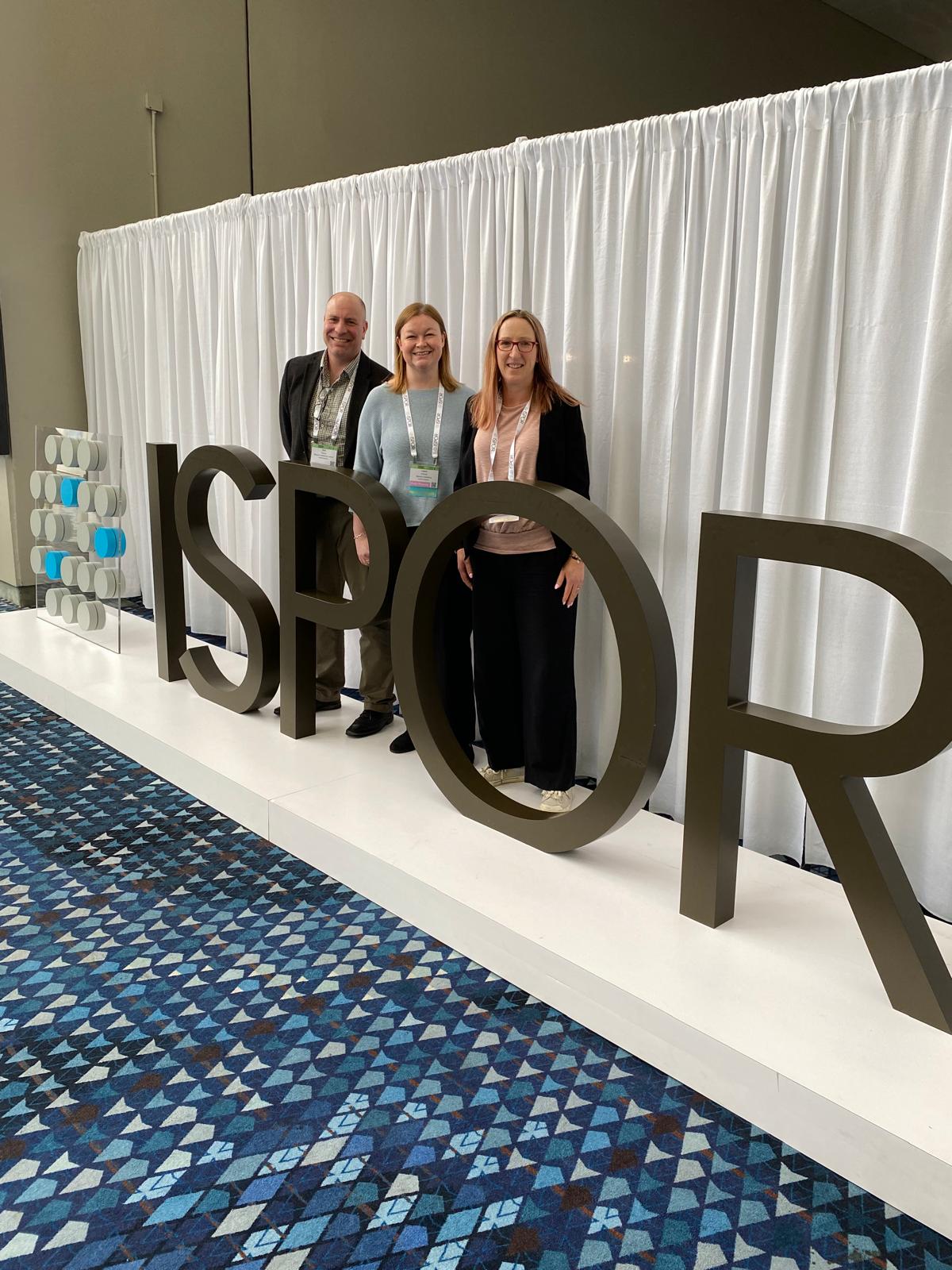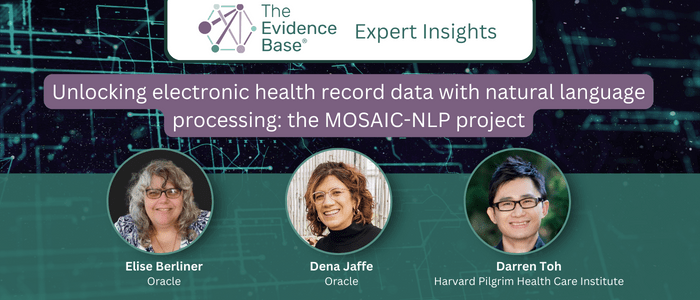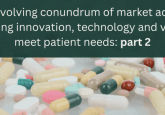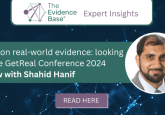ISPOR 2024 daily round-ups: Day 3
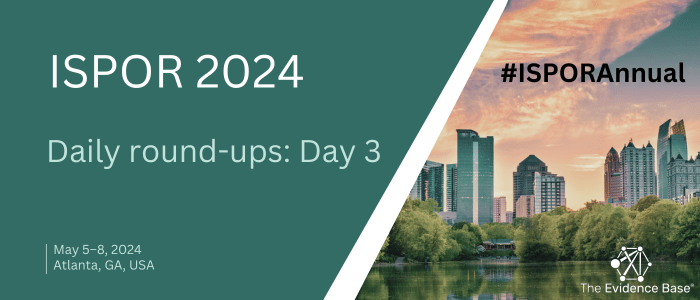
As ISPOR 2024 (May 6–8, 2024; Atlanta, GA, USA; #ISPORAnnual) comes to a close, in our final round-up we summarize some of the key sessions and presentations from Day 3 of the conference. Our thanks again to ISPOR — The Professional Society for Health Economics and Outcomes Research for welcoming The Evidence Base as a media partner for the conference.
We also thank our ISPOR 2024 event partners for their support: Avalere, Cardinal Health, Cencora, Flatiron Health, Genesis Research Group, Lane Clark & Peacock LLP and Medlior Health Outcomes Research. Over the next few weeks we’ll be providing in-depth insights from several of their sessions and research posters – register on The Evidence Base to receive regular updates and be notified when this coverage is published on the site.
Finally, we appreciate the support of Maxis Clinical Sciences and Carrot Recruitment, our Talent Hub partner.
Click below to read the coverage of Days 1 and 2.
Final address
Rob Abbott (CEO and Executive Director, ISPOR) thanked the ISPOR Board of Directors and paid tribute to Brian O’Rourke, ISPOR President 2023–2024, on his efforts in creating a new strategic plan for the society. He also thanked outgoing and welcomed new members to the Board. Abbott reiterated his gratitude to the ISPOR Conference Chairs for their role in pulling together hundreds of hours of content from the past few days:
- Charlene Wong, Senior Advisor for Health Strategy in the Office of the Director at the Centers for Disease Control and Prevention
- Nancy Dreyer, President, Dreyer Strategies LLC, Adjunct Professor of Epidemiology at the University of North Carolina at Chapel Hill, and Chief Scientific Advisor to Picnic Health
- Thomas Senderovitz, Senior Vice President Data Science at Novo Nordisk
Laura Pizzi (Chief Science Officer, ISPOR) talked the audience through ISPOR’s science and health policy activities, covering eight HEOR themes which include:
- Advancing science of HEOR, including the update and use of ISPOR reports by global policy initiatives
- Responding to policymakers, such feedback on as Joint Clinical Assessment in Europe and CMS policies in the US
- Building HEOR capacity worldwide, through working with the Gates Foundation as an example
Abbott closed ISPOR by welcoming attendees to upcoming conferences – ISPOR Europe 2024 in Barcelona, Spain (November 17–20, 2024) and ISPOR 2025 in Montréal, Canada (May 13–16, 2025)
Plenary 3 – AI Enabling Whole Health: Opportunities and Challenges for HEOR and HTA
Closing ISPOR 2024, the final plenary explored the intersection of AI, HEOR and HTA. Program Chair Thomas Senderovitz (Novo Nordisk, USA) was joined by Anirban Basu (University of Washington, USA), Alexandra Berk (CVS Healthspire Life Sciences Solutions, USA) and Rachael Fleurence (NIH, USA). For insights into Plenary 3, check out our full coverage.
Spotlight session – How to Adjust Economic Models for Health Equity in the Conduct of Generalized Cost-Effectiveness Analysis (GCEA)
Nancy Devlin (University of Melbourne, Australia) introduced the session by calling out the synergy between the topic to be discussed with the new ISPOR mission – an emphasis on the importance of health equity. She began by sharing some of the definitions of health equity, including that provided by the CMS and the WHO. What do these definitions imply for decision-making and methods of analysis that inform research allocation in health care and therefore the conduct of cost-effectiveness analysis (CEA)? Are there more explicit and systematic ways to incorporate health equity into CEA to better reflect health system objectives?
William Padula (University of Southern California, USA) provided an overview of GCEA and the role of equity. He started by discussing the ISPOR flower, with novel value elements being added. He discussed the measurement of novel value elements and flaws in the incremental cost-effectiveness ratio (ICER), with variability in the threshold for interpretation of the ICER with the degree of relative risk over consumption. GCEA is a form of cost-effectiveness that incorporates combinations of novel value elements as appropriate to represent the true value of health technology.
Darius Lakdawalla (USC Leonard D. Schaeffer Center for Health Policy and Economics, USA) built on his presentation from the Day 2 Issue Panel entitled, “I Have a Better QALY Than You: How to Make Sense of Alternatives to the QALY for Research and Policymaking,” and described the role of generalized risk-adjusted cost-effectiveness (GRACE) in addressing equity. He highlighted the multiple reasons for policymakers, the public and researchers to focus on health equity, but acknowledged there are challenges. Traditional quality-adjusted life years (QALYs) pose obstacles to the logically consistent measurement of inequity in distributional CEA (DCEA). He provided an overview of GRACE-enabled DCEA, which holds with the Pareto principle. GRACE utility functions can be estimated for a range of populations, facilitating targeted and rigorous analysis of inequality. GRACE also avoids discriminating against those with disabilities.
Anirban Basu, also a speaker on the Day 2 Issue Panel with Lakdawalla, carried on the discussion by presenting approaches to utility measurement and threshold adjustment from a health equity perspective; specifically, the health years in total (HYT) measurement. He acknowledged that health equity can be incorporated in CEA in different ways, but it important to do this in a transparent way. Debate continues about whether to codify these impacts through specific parameters or a deliberative process, and he concluded that the decision ultimately lies with decision-makers, not analysts.
Finally, Vasco Pontinha presented on a novel method to encapsulate health equity based on budgetary constraints – the Generalized Dynamic Prevalence (GDP) Curve. He began with the question of why willingness to pay (WTP) thresholds should be adjusted for conditions with limited therapeutic alternatives and that affect fewer patients, compared with the general population. Currently, all diseases are valued at the same WTP, which is in direct contradiction with the EU theoretical framework that expects different opportunity costs for different outcomes. The GDP Curve attempts to address this by adjusting WTP, and Pontinha highlighted that this is not an ‘apologetic’ approach, but rather a way to describe how opportunity costs are much higher for rare/severe conditions.
Concurrent sessions
Concluding Day 3 of ISPOR 2024, several breakout sessions provided further learning opportunities focused on addressing gaps in clinical outcomes assessment measurement in real-world studies, exploring novel methods in HEOR, discussing global consequences of recent legislative changes in the US and Europe, and proposing solutions for challenges in RWE studies.
Workshop – International Fallout: How the Inflation Reduction Act (IRA) in the US and Joint Clinical Assessment (JCA) and Revision of the EU Pharmaceutical Strategy in Europe Will Have Global Consequences
David Alderson (Cogentia Healthcare Consulting, UK) welcomed panelists Diana Brixner (Pharmacotherapy Outcomes Research Center, University of Utah College of Pharmacy, USA), Christopher Teale (TealeHealth, UK) and Sam Mettam (Jazz Pharmaceuticals, UK). They explored the implications and intended and unintended consequences of the IRA, JCA and the revision of the EU Pharmaceutical Legislation on healthcare systems and R&D. Alderson acknowledged the broad number of sessions exploring these topics at ISPOR 2024, which discussed their processes, challenges and uncertainties.
Brixner explored opportunities for the US to learn from the European experience in negotiating drug prices with governments and other policy makers. Brixner acknowledged the ‘spillover’ effect of the IRA, noting it will extend to beyond the Medicare population in the US and lead to lower resources for global drug development. She concluded by noting European companies and pricing experts will need to evolve their clinical development decisions to adapt for the downstream impact of the IRA.
Teale likened the approaching harmonization of European HTA, through JCA, and revision to EU Pharmaceutical Legislation as a ‘perfect storm’ in Europe. Teale compared the nuances of EU HTA and the IRA, noting several differences including EU JCA taking place at the beginning of a product’s lifecycle, with often limited data, whilst the IRA looks at the end of a product’s life where there is an abundance of evidence. Teale expressed concern JCA will slow down patient access to novel medicines and result in a decline in investment by companies in Europe. He called for further guidance in several areas, particularly in generating evidence through comparative real-world data.
Providing the company perspective, Mettam explored the challenges of the IRA and JCA through a case study scenario, asking the audience to take the role of a Global Value and HEOR lead for a drug in Phase III development. Through interactive polling, Teale explored several situations to determine the most appropriate strategies to generate the evidence for JCA and IRA. He concluded with a ‘one size probably doesn’t fit all’ approach is needed, with companies needing to strategize for maximizing the evidence per dollar and minimizing the impact of any failures.
The panel hoped for an exchange of information through the two policies, with the CMS learning from the JCA decisions and European HTA and pricing decision-makers noting the CMS pricing decisions in future pricing agreements.
Workshop – Silence Is Not Always Golden: The Value of Engagement for Collection of Patient Experience Data in Drug Development
Discussion Leader, Danny Yeh (AESARA, USA) was joined by Ebony Dashiell-Aje (BioMarin Pharmaceutical, USA), and Natalie Engmann (Denali Therapeutics, San Francisco, CA, USA) and Selena Daniels (US FDA, USA).
Yeh began the session by introducing what is meant by patient experience data (PED), which is defined in the 21st Century Cures act as, “information about the impact of a medical condition or a related therapy on a patient’s life and the patient’s preferences for treatment.” Yeh highlighted that interest in PED is increasing, with the release of FDA methodology guidance on its measurement, with pharmaceutical companies hiring chief patient officers, and with an increase in PED-focused scientific publications; however, there are still gaps in the overall understanding of PED and its use in regulatory decision-making.
Daniels, from the Division of Clinical Outcome Assessment, spoke next, and provided the regulatory perspective on the value of working with them for the collection of PED. She highlighted that the goal of the FDA is to understand patient perspectives on benefits and risks, and explained some of the terminology used, including clinical benefit – a positive, clinically meaningful effect of an intervention – and clinical outcome – an outcome that describes or reflects how an individual feels, functions or survives.
Daniels briefly ran through the FDA Patient-Focused Drug Development (PFDD) Guidance Series, including:
- PFDD Guidance 1 – how to collect comprehensive and representative input
- PFDD Guidance 2 – how to identify what is important to patients
- PFDD Guidance 3 – how to select, develop or modify fit-for-purpose COAs (in draft)
- PFDD Guidance 4 – how to incorporate COAs into end points for regulatory decision making (in draft)
After running through the different types of meetings that can be requested with the FDA (dependent on the question[s] being asked), which include in-person meetings, virtual and written response only (WRO), Daniels shared some tips, including engaging early and often, having a clear idea of the objectives of the patient engagement strategy, knowing whose input is needed in order to request appropriate attendees, and making every interaction count with good preparation and targeted questions – highlighting that there is no one size fits all.
Dashiell-Aje spoke next, describing the BIO FDA–Sponsor Engagement Framework to guide interactions within and beyond the IND process. She acknowledged the great progress in the provision of regulatory guidance, but also emphasized the need for a roadmap to help industry understand when, how and who to engage.
Dashiell-Aje re-emphasized the importance to engage with FDA early and often, but acknowledged there are challenges to this, including knowing when/how/who and the difficulty in obtaining timely meetings. There are therefore opportunities for improvement and the BIO framework is designed to guide interactions within and beyond the IND process. Elements of the framework include key milestones at which sponsors should engage with the FDA, types of information to provide, key questions to pose, appropriate meeting pathways, and disciplines that should be considered for the interaction.
Engmann represented the perspective of a small biotech company navigating the use of PED, and focused on clinical outcomes assessment (COA) measure, and discussed the challenges faced, including:
- Therapeutic area – each of which will have its own set of challenges with respect to COA strategy, such as a lack of disease-specific COA availability or a lack of natural history data
- Organizational challenges – investment in COA resourcing and research activities must begin before you know if your drug is viable, so will be happening at risk. This is very challenging for small companies, but even for larger organizations
- Development timelines – broader development timelines may or may not prioritize a fit-for-purpose COA strategy
Discussion how these might be overcome, Engmann shared two examples, including the MLD-HOME Natural History Study and the Critical Path Institute (C-Path), highlighting that precompetitive consortia efforts can help reduce barriers to COA strategy by leveraging expertise from multiple stakeholders, with cost and data sharing.
Engmann concluded by sharing her tips from the small biotech perspective, including resourcing COA teams as early as possible, leveraging your patient advocacy team (if you have one), not making, “the perfect the enemy of the good” but know where you are taking risks, maximizing your opportunities for regulatory feedback on COA, recognizing that global development strategies require global regulatory input, and exploring precompetitive efforts such as consortia. She emphasized that small teams can have an outsized impact by leading with technical rigor, prioritizing collaboration and maximizing opportunities for regulatory feedback.
The overall takeaway from the session was the importance of early and frequent interactions between regulators, industry sponsors and patients.
Workshop – Getting Real About Real-World Data from Electronic Health Records
Rachele Hendricks-Sturrup (Duke-Margolis Center for Health Policy, USA) began the session and introduced fellow panelists Elise Berliner (Oracle Life Sciences, USA) and Mac Bonafede (Veradigm, USA).
After talking the audience through the specifics of RWD and RWE, Hendricks-Stirrup presented research carried out by Duke-Margolis on the use if EHR data by health systems to inform patient care delivery which shows diverse usage of the data within these systems. Running the RWE Collaborative at Duke-Margolis, Hendrick-Stirrups discussed new research by the group looking at operationalizing EHR-source data to improve the quality, relevancy and reliability of data found in EHRs. She went on to outline the challenges with EHR-sourced data, including heterogeneity and loss of context and introduction of bias across the EHR data life cycle.
Up next, Berliner discussed a new 2-year project called, ‘Multi-source Observational Safety Study for Advanced Information Classification Using NLP’ (MOSAIC-NLP) funded by the US FDA through the Sentinel Innovation Center. The project aims to advance the validity of population-based pharmacoepidemiologic studies by leveraging natural language processing (NLP) to extract RWD from 17 million clinical notes within EHRs. Using montelukast as a use case, in broad terms the project is exploring NLP to explore neuropsychiatric events associated with taking montelukast, which are often reported within the unstructured data of EHRs. To learn more about this project, read our interview with Elise Berliner and colleagues here.
Bonafede provided an overview of the Veradigm RWD offering, which includes Veradigm Network EHR data, providing EHR data for over 174 million patients in the US, registries including over 13 millions patients and a comprehensive claims dataset. They are leveraging this data to offer extensive insights into US population health and offer EHRs as a ‘conduit’ for better evidence-based decisions for clinicians and other stakeholders.
On demand access to ISPOR 2024 sessions
For individuals who were unable to attend the ISPOR session or participate in ISPOR 2024, ISPOR is offering a ‘Digital Conference Pass‘ option. This pass provides convenient on-demand access to recordings of a wide array of educational sessions, plenaries, spotlights, and additional content. Below are some key highlights from the sessions on Day 2 of ISPOR 2024, which can be accessed through this pass.
- Target Trial Emulation in Practice: An Introduction and Exploration of Application Through Case Studies – Discussion Leader: Alind Gupta, University of Toronto, Canada
- Gaps in Clinical Outcomes Assessment Measurement in Real-World Studies: Solutions and Applications – Discussion Leader: Bryan Bennett, Jazz Pharmaceuticals, UK
- Real-World Evidence for Crossover Adjustment: Challenges, Opportunities, and Newly Proposed Methods – Discussion Leader: Shannon Cope, PRECISIONheor, Canada
- Amplifying HEOR Studies Using Real-World Electronic Health Record Data – Presenter: Michiel Niesen, nference, USA
- The Invisible Costs in Rare Disease Management: Who Bears the Expense? – Moderator: Nicole Lyn, Sanofi, USA
Looking ahead
The Evidence Base will be continuing our coverage of the ISPOR conferences and are looking ahead to ISPOR Europe 2024 in Barcelona, Spain (November 17–20, 2024). If you are interested in showcasing your thought leadership and expertise in the field pre- and post-conference, then please get in touch. Sponsorship options include session deep dives, poster presentation insights, expert interviews, videos, webinars, and more.
Learn more on our Sponsorship page or contact Phil Garner, Co-Founder & CEO, for more information on how to partner with us for these important events.
Goodbye for now – that’s a wrap and see you at the next conference!
